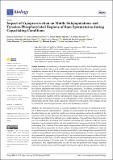Por favor, use este identificador para citar o enlazar a este item:
http://hdl.handle.net/10261/265038COMPARTIR / EXPORTAR:
 SHARE SHARE
 CORE
BASE CORE
BASE
|
|
| Visualizar otros formatos: MARC | Dublin Core | RDF | ORE | MODS | METS | DIDL | DATACITE | |

| Título: | Impact of cryopreservation on motile subpopulations and tyrosine-phosphorylated regions of ram spermatozoa during capacitating conditions |
Autor: | Peris-Frau, Patricia CSIC ORCID; Sánchez-Ajofrín, Irene; Martín-Maestro, Alicia CSIC ORCID; Maside, Carolina CSIC ORCID; Medina-Chávez, Daniela-Alejandra CSIC; García-Álvarez, Olga CSIC ORCID; Fernández-Santos, M. Rocío CSIC ORCID; Montoro, Vidal CSIC ORCID; Garde, José Julián CSIC ORCID; Ramón, Manuel CSIC ORCID ; Soler, Ana J. CSIC ORCID | Palabras clave: | Computer-assisted sperm analysis Tyrosine phosphorylation Cytometry Sperm cryopreservation Subpopulations Sperm capacitation |
Fecha de publicación: | 2021 | Editor: | Multidisciplinary Digital Publishing Institute | Citación: | Biology 10(11): 1213 (2021) | Resumen: | The heterogeneous nature of ejaculates highlights the relevance of studying the behavior of different sperm subpopulations. Changes in sperm motility and the increase in tyrosine phosphorylation are key events that usually occur during capacitation and can be modified by the cryopreservation process. However, the relationship between both events remains poorly defined throughout capacitation in the different sperm subpopulations. Fresh and frozen-thawed spermatozoa were incubated in capacitating (CAP) and non-capacitating (NC) media up to 240 min. Sperm kinematics, tyrosine phosphorylation and mitochondrial activity were measured by the CASA system and imaging flow cytometry. Four motile sperm subpopulations (SP) were identified in fresh and frozen-thawed ram semen after the cluster analysis. Incubation under CAP conditions over time led to greater changes in the percentage of spermatozoa included in each subpopulation compared to NC conditions, being different between fresh and frozen-thawed spermatozoa. The SP1, characterized by slow spermatozoa, progressively increased after 15 min in frozen-thawed samples incubated in both media but not in fresh ones. The SP4, characterized by fast and non-linear spermatozoa, showed a marked increase during CAP, but not under NC conditions, occurring more rapidly in frozen-thawed spermatozoa. This subpopulation (SP4) was also the only one positively and strongly correlated with mitochondrial activity and all phosphorylated sperm regions during capacitation, either in fresh or frozen-thawed samples. Our results indicated that in vitro capacitation induced significant changes in the distribution of motile sperm subpopulations, being affected by cryopreservation. Notwithstanding, the subpopulation which probably represents hyperactivated-like spermatozoa (SP4) also increased in frozen-thawed samples, occurring faster and simultaneously to the increment of mitochondrial activity and tyrosine phosphorylation of different sperm regions. | Descripción: | This article belongs to the Special Issue Factors Affecting In Vitro Assessment of Sperm Quality. | Versión del editor: | https://doi.org/10.3390/biology10111213 | URI: | http://hdl.handle.net/10261/265038 | DOI: | https://doi.org/10.3390/biology10111213 | E-ISSN: | 2079-7737 |
| Aparece en las colecciones: | (IREC) Artículos |
Ficheros en este ítem:
| Fichero | Descripción | Tamaño | Formato | |
|---|---|---|---|---|
| impacondit.pdf | 1,79 MB | Adobe PDF |  Visualizar/Abrir |
CORE Recommender
Page view(s)
36
checked on 15-may-2024
Download(s)
48
checked on 15-may-2024
Google ScholarTM
Check
Altmetric
Altmetric
Este item está licenciado bajo una Licencia Creative Commons

